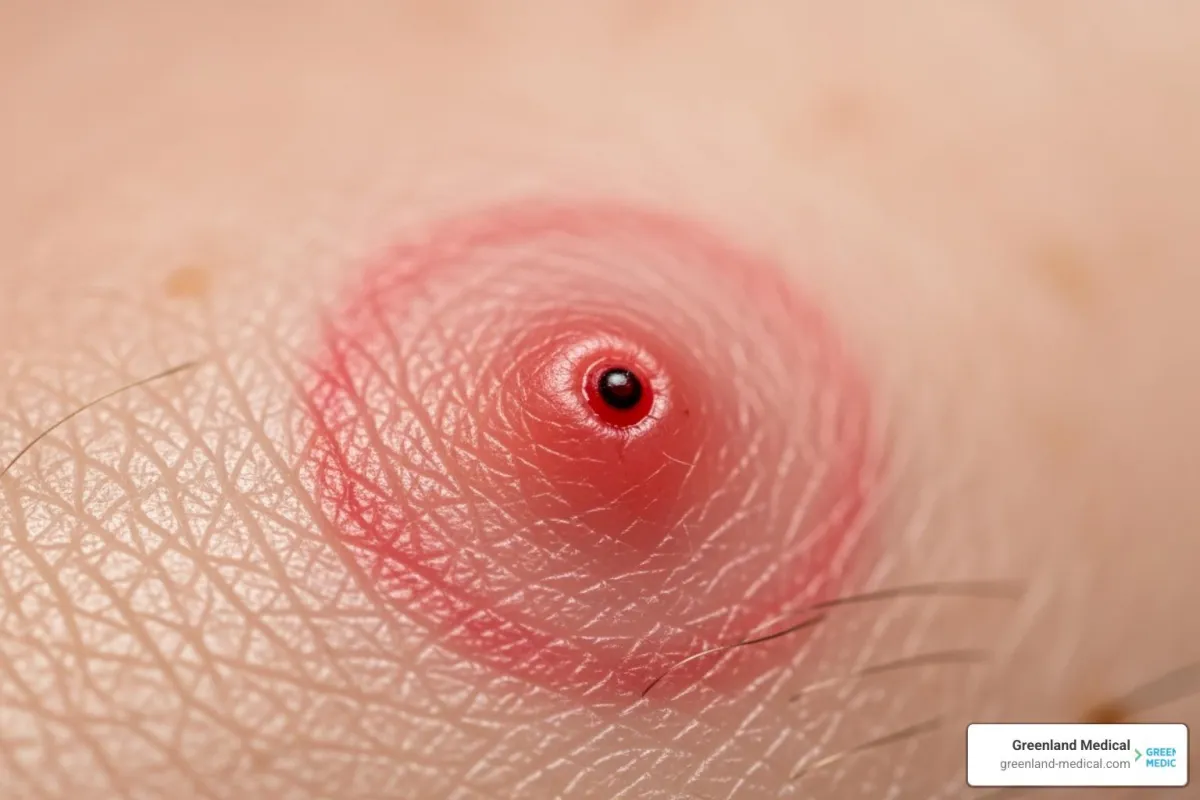
A Visual Guide to Tick Bites—Because Bugs Bite
Why Recognizing Tick Bite Appearance Matters for Your Health
What do tick bites look like isn't always straightforward - these small arachnids can leave marks ranging from barely visible pinpricks to distinctive rashes that signal serious illness.
Quick Answer - Tick Bite Appearance:
Simple bite: Small red bump, black dot, or skin-colored nodule (often painless)
No reaction: Many bites show no visible signs at all
Allergic reaction: Swelling, itching, blistering around bite site
Disease rash: Bull's-eye pattern (Lyme), blotchy spots (Rocky Mountain Spotted Fever)
On darker skin: May appear bluish or bruise-like, harder to spot
Most tick bites cause no physical signs or symptoms. When they do appear, they typically look like a small bump resembling a mosquito bite. However, the real concern isn't the bite itself - it's what comes after.
About 70% to 80% of people infected with Lyme disease develop the characteristic bull's-eye rash within 3 to 30 days. Rocky Mountain spotted fever creates a different pattern - small, flat, pink spots that can spread and turn red or purple. These visual clues can be the difference between early treatment and serious complications.
Unlike mosquito bites that itch immediately, tick bites often go unnoticed because ticks inject numbing saliva. You might only find you've been bitten when you find the tick still attached or when symptoms develop days later.
As Dr Andrew Greenland, I've spent years helping patients steer complex chronic illnesses, including tick-borne diseases that conventional medicine often misses. Understanding what do tick bites look like is crucial for early intervention and preventing the long-term health impacts I see too often in my functional medicine practice.
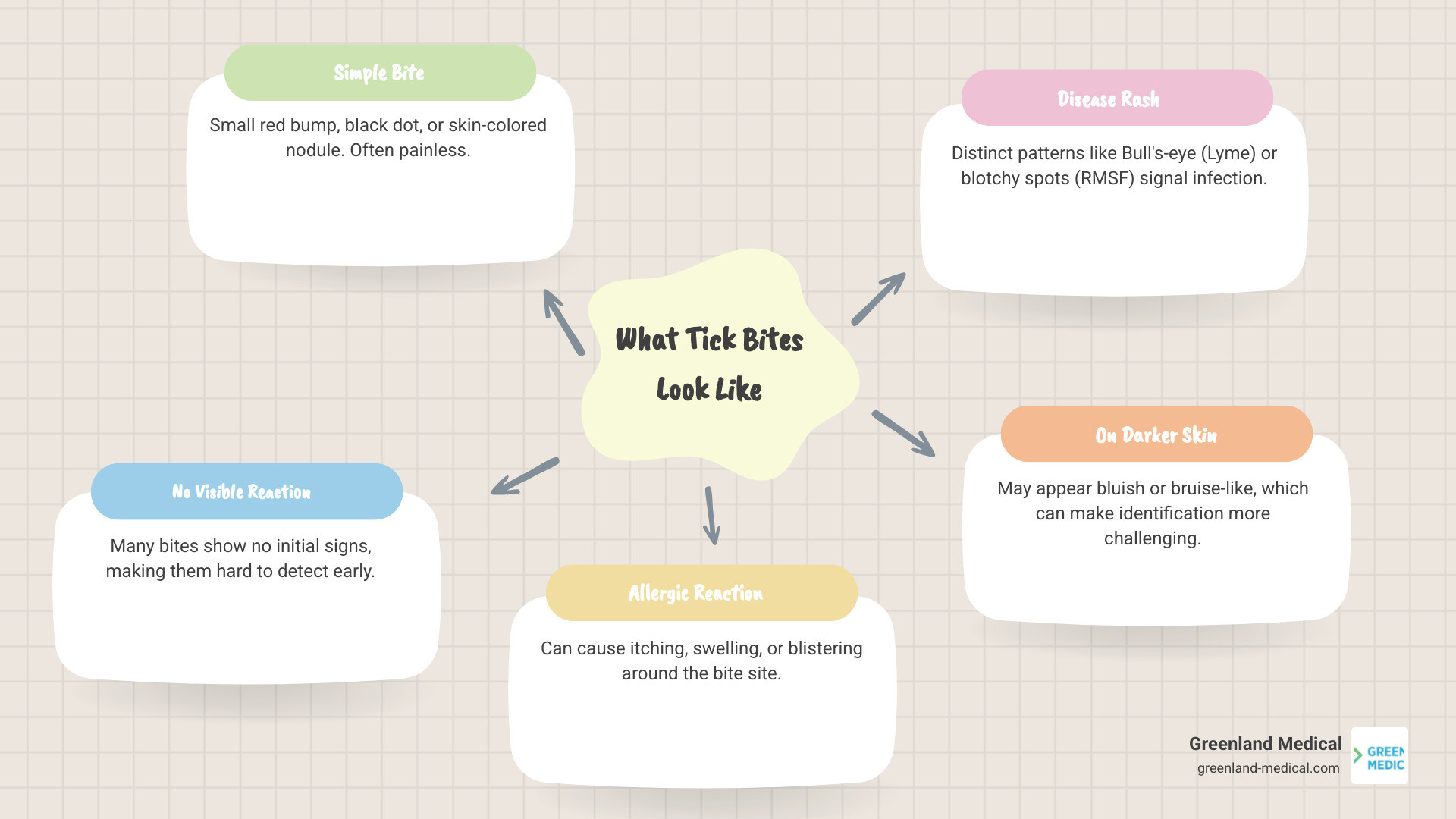
What Do Tick Bites Look Like? From a Simple Bump to a Telltale Rash
Here's the tricky thing about tick bites - they're master disguise artists. These tiny arachnids, no bigger than a pencil eraser (and sometimes as small as a pinhead), have evolved to be incredibly sneaky about their dining habits.
When a tick settles in for a meal, it doesn't just bite and fly away like a mosquito. Instead, it burrows its head into your skin and makes itself comfortable for what could be days or even up to two weeks. The real kicker? Their saliva contains natural numbing agents, so you likely won't feel a thing.
This means what do tick bites look like depends entirely on timing and your body's unique response. You might find the bite when you find the tick still attached, or days later when other symptoms start appearing.
Most tick bites create a single lesion that looks remarkably similar to a mosquito bite - just a small red bump. But here's where it gets interesting: some people show no reaction at all, while others experience significant allergic reactions with intense itching, swelling, or even blistering around the bite area.
Characteristic Tick Bite Mosquito Bite Spider Bite (Rare) Appearance Single lesion, small red bump, black dot, or skin-colored nodule. May have visible tick attached. Can develop into rash. Itchy, red or white, puffy bump. Often multiple bites in clusters. Rare. Usually two equally spaced dots (fang marks). Can be red, swollen, painful. Itchiness May or may not be itchy. Often painless initially due to numbing saliva. Usually very itchy. Can be itchy or painful, depending on the spider. Pain Often painless. Mild to moderate itchiness. Can be painful. Attachment Tick often remains attached for hours to days. Does not remain attached. Does not remain attached. Rash Can cause various rashes, including bull's-eye (Lyme), blotchy (RMSF). No characteristic rash pattern. No characteristic rash pattern.
What does a simple tick bite look like?
In its simplest form, a fresh tick bite might appear as nothing more than a small pinprick or black dot on your skin. Sometimes it looks like a skin-colored nodule or even resembles a small bruise-like mark.
The painless nature of these bites, thanks to that numbing saliva, means many people only find they've been bitten during their post-outdoor body checks. This is exactly why those thorough tick searches after hiking or gardening are so crucial.
Some people do experience itching if they're particularly sensitive to tick saliva, but don't count on discomfort to alert you to a bite. The tick's evolutionary strategy relies on staying undetected for as long as possible.
For more detailed information about how different people react to tick bites, you can explore more info about tick bite reactions.
What does a tick bite look like on different skin tones?
This is where tick bite identification becomes especially challenging, and unfortunately, where health disparities can emerge.
On lighter skin tones, tick bites and their associated rashes typically show up as red, scabby areas with clearly defined borders. The classic Lyme disease bull's-eye rash appears as a distinct red ring that's relatively easy to spot.
However, on darker skin tones, the same bite might appear bluish, brownish, or look remarkably similar to a common bruise that you might easily dismiss. The erythema migrans rash associated with Lyme disease can present as subtle pink patches, generalized redness, or bruise-like discoloration that's much harder to spot against darker skin.
This difference in appearance isn't just cosmetic - it can lead to delayed recognition and treatment, which is why being extra vigilant about other symptoms becomes even more important for people with darker skin tones.
Decoding Rashes: When a Bite Signals a Deeper Issue
Here's where things get serious. While a simple red bump might just be your body's way of saying "something bit me," certain rashes are your skin's alarm system going off. These distinctive patterns can signal tick-borne illnesses that need immediate attention.
The tricky part? What do tick bites look like when they're carrying disease is completely different from a harmless bite. We're talking about rashes that can appear days or even weeks after the initial bite, when you might have forgotten all about that outdoor adventure.
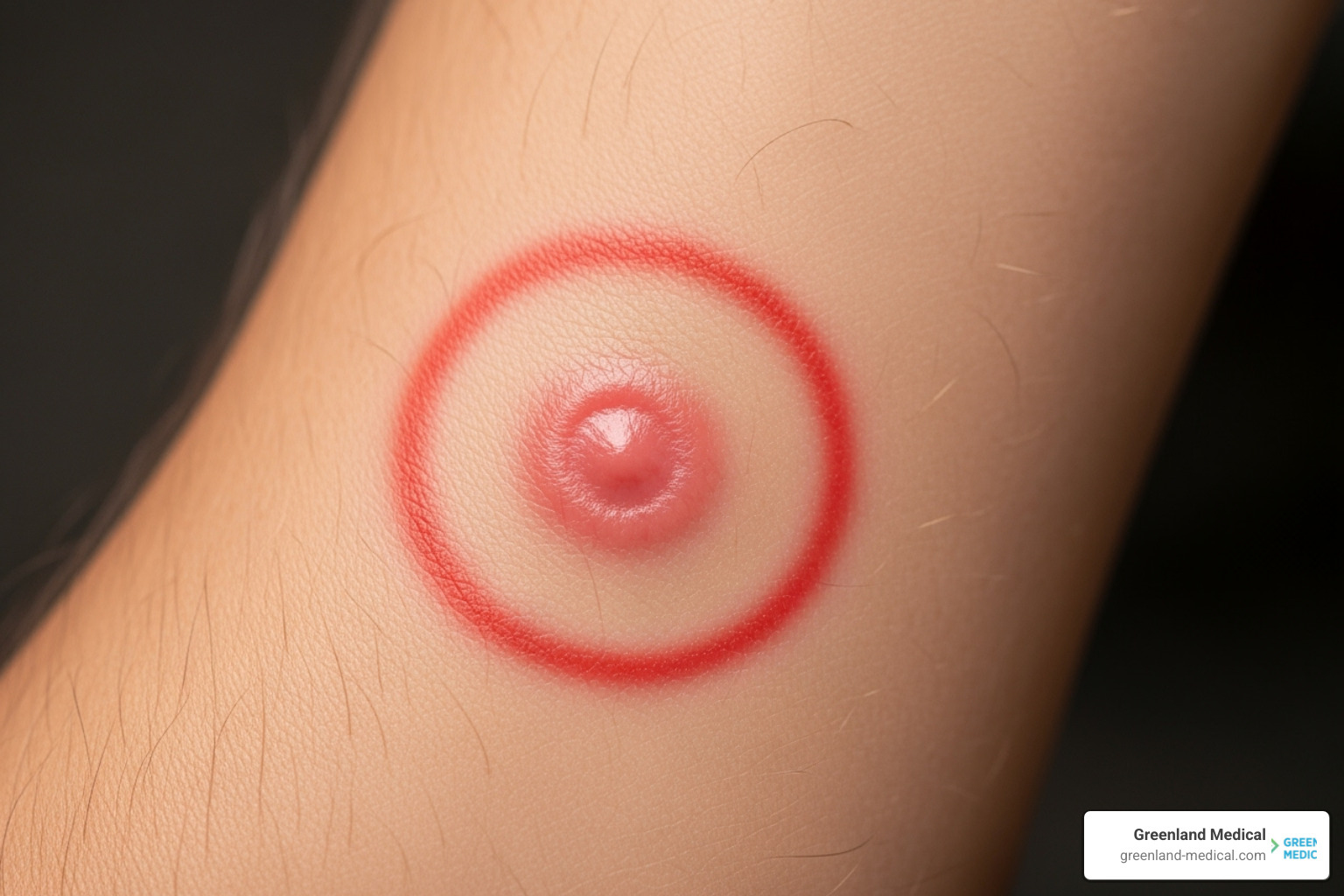
The most famous of these warning signs is the bull's-eye rash from Lyme disease. But Rocky Mountain spotted fever creates its own calling card with blotchy, widespread spots. Southern tick-associated rash illness (STARI) throws in another bull's-eye variation just to keep things interesting.
Here's what makes this especially challenging: while you're watching for rashes, your body might be fighting the infection with flu-like symptoms that feel like you're coming down with something. We're talking fever, chills, headache, and that bone-deep fatigue that makes you want to crawl back into bed.
The reality is that not every tick-borne disease gives you a rash, but almost all will make you feel like you've been hit by a truck.
The Lyme Disease "Bull's-Eye" Rash (Erythema Migrans)
Let's talk about the celebrity of tick bite rashes - the bull's-eye. This distinctive circular rash, called erythema migrans, shows up in about 70% to 80% of people who get Lyme disease. But here's the catch: it doesn't always look like the textbook pictures.
The rash typically makes its grand entrance 3 to 30 days after the tick bite, often with the original bite mark sitting right in the center like a bullseye target. It starts small and then slowly expands outward, sometimes reaching 6 inches across, and occasionally growing up to 12 inches or more.
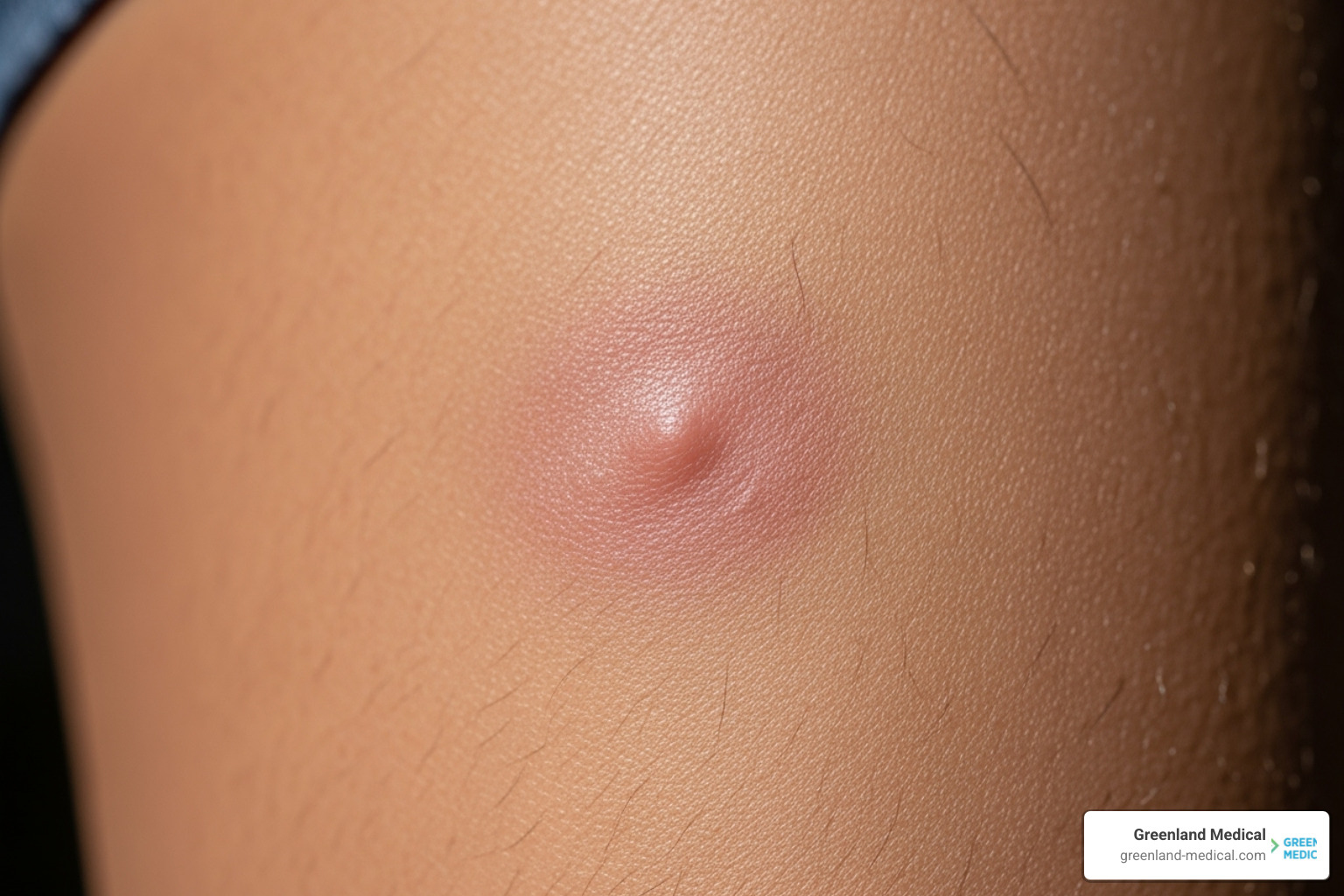
What makes it distinctive is how the center often clears up, creating that classic target appearance. You might notice it feels warm to the touch, but surprisingly, it's usually not painful or itchy - unlike most other rashes that demand your attention with constant scratching.
But here's something important that many people don't realize: the perfect bull's-eye rash actually happens in less than half of Lyme disease cases. Sometimes it just looks like a solid red patch, or it might not appear at all. This is why paying attention to other symptoms is crucial.
For detailed information about how these rashes can vary, check out this resource: CDC information on Lyme disease rashes.
Other Tick-Borne Illness Rashes
Lyme disease isn't the only tick-borne illness with a signature look. Each disease seems to have its own artistic style when it comes to rashes.
Rocky Mountain Spotted Fever creates a completely different pattern. Instead of neat circles, you get small, flat, pink spots that typically start on your wrists and ankles about two to five days after symptoms begin. These spots have attitude - they spread from your extremities inward and often turn red or purple after about a week.
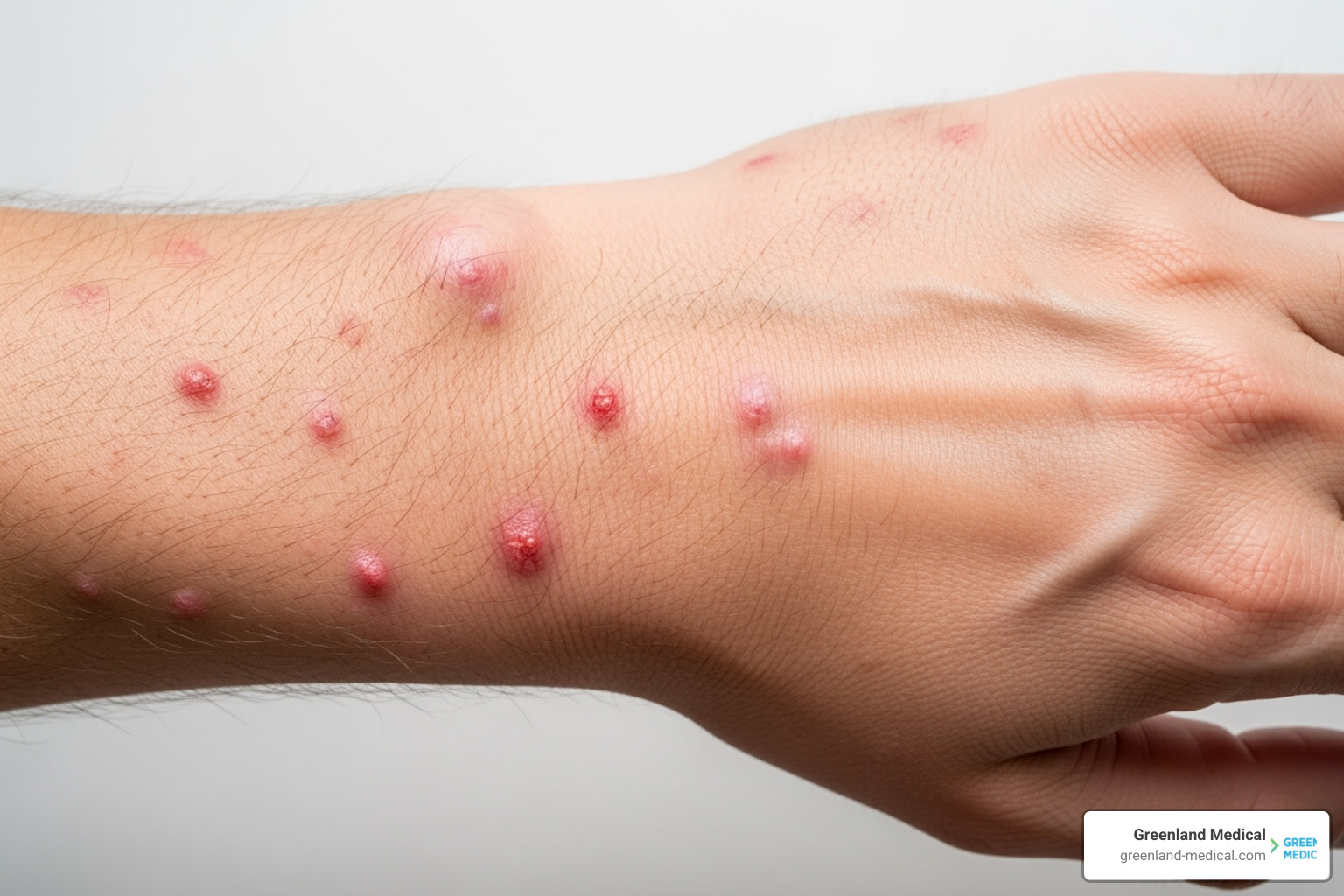
The RMSF rash is blotchy and widespread, nothing like the organized circles of Lyme disease. What's particularly frustrating is that some people with Rocky Mountain spotted fever don't develop a rash at all, making diagnosis like solving a puzzle with missing pieces.
Southern Tick-Associated Rash Illness (STARI) tries to copy Lyme disease's homework but doesn't quite get it right. It also creates a bull's-eye pattern with the bite mark at the center, but this rash is typically more modest, expanding to no more than 3 inches across.
Tularemia takes a more dramatic approach, creating a painful open sore right where the tick attached. There's no mistaking this one - it's like your skin is sending up a flare.
Ehrlichiosis seems to have a preference for children when it comes to rashes. It can show up as small, flat, red or purple spots, or sometimes as red areas covered with small bumps. It's less predictable than the others, which keeps doctors on their toes.
Understanding these different patterns isn't just medical trivia - it's potentially life-saving information. Each of these illnesses requires specific treatment, and the sooner you recognize the signs, the better your chances of a full recovery.
Found a Tick? Here's Your Step-by-Step Action Plan
Finding a tick attached to your skin can feel alarming, but don't panic. The good news is that proper removal within the first 24 hours significantly reduces your risk of contracting a tick-borne disease. Most ticks need to feed for more than 24-36 hours before they can transmit infections like Lyme disease.
The key is acting quickly and doing it right. Forget everything you've heard about nail polish, petroleum jelly, or lighting matches near the tick. These old remedies can actually make things worse by irritating the tick and causing it to release more saliva (and potentially more bacteria) into your bloodstream.
Here's what actually works: fine-tipped tweezers and steady hands.
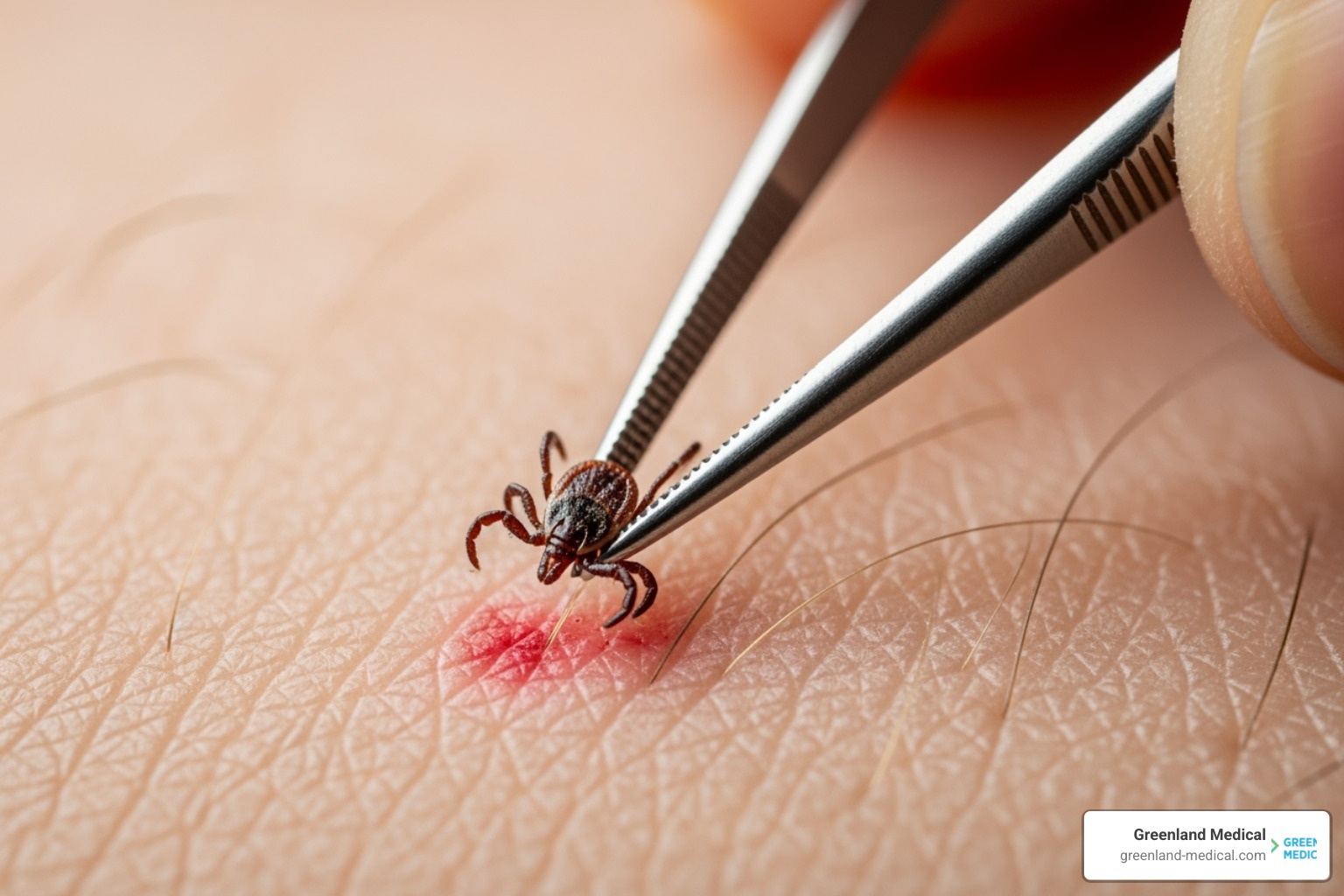
Grab the tick as close to your skin as possible using fine-tipped tweezers. You want to get right down to where the tick's mouth meets your skin. If you don't have tweezers handy, a tissue or paper towel can work in a pinch, but tweezers give you much better control.
Pull upward with steady, even pressure. No twisting, no jerking, no sudden movements. Think of it like removing a splinter - slow and steady wins the race. The goal is to get the whole tick out in one piece.
After removal, take a close look at the bite site. You want to make sure you got everything, including the tick's mouthparts. If you see small dark pieces still embedded, try to remove them with your tweezers. Don't worry if you can't get them out - they'll usually work their way out naturally as your skin heals.
Now for disposal - you have several options. Flush it down the toilet, drop it in rubbing alcohol, or seal it in a bag with tape. Some people like to save the tick in a labeled container with the date and location where they found it. This can be helpful if you develop symptoms later and need to show it to a doctor.
How to Treat the Bite Area After Removal
Once the tick is gone, your job isn't quite finished. Proper aftercare helps prevent infection and gives you the best chance of spotting any problems early.
Start with a thorough cleaning. Wash the bite area well with soap and water, then follow up with rubbing alcohol. This helps kill any bacteria that might be lingering on your skin.
Consider applying antibiotic ointment if the bite area looks inflamed or starts to form a scab. This isn't always necessary for every tick bite, but it can help reduce the risk of secondary bacterial infection and calm any inflammation.
The most important step? Monitor the area for 30 days. I can't stress this enough - many tick-borne diseases don't show symptoms immediately. Watch for changes like unusual swelling, skin discoloration, soreness, or the development of any rash. What do tick bites look like can change dramatically over time, especially if disease develops.
If the bite becomes itchy (which doesn't always happen), you can apply anti-itch cream or calamine lotion. A cold compress can also help with swelling and provide some relief.
That most tick bites are completely harmless and heal without any issues. But staying vigilant during that first month gives you the best chance of catching any problems while they're still easy to treat.
When to See a Doctor About a Tick Bite
Most tick bites heal on their own without any fuss, but sometimes your body sends signals that something more serious might be brewing. The tricky thing about tick-borne illnesses is that they often start quietly, disguising themselves as common ailments you might brush off.
Rash development is your biggest red flag. If you notice any new rash appearing days or weeks after spending time outdoors, especially the classic bull's-eye pattern, don't wait to see if it goes away. Even a blotchy, widespread rash that doesn't look like the textbook Lyme disease pictures deserves medical attention.
Flu-like symptoms are another major warning sign that many people dismiss, especially during cold and flu season. We're talking about fever, chills, headache, fatigue, or those deep muscle and joint aches that make you feel like you've been hit by a truck. These symptoms can appear anywhere from days to weeks after a tick bite, and they're often the first sign your immune system is fighting a tick-borne infection.
Pay attention to what's happening right at the bite site too. Persistent redness, swelling, pain, warmth, or any drainage around the area could indicate a localized infection that needs treatment.
The neurological symptoms are the ones that really get our attention at the clinic. Tingling or numbness, neck stiffness, facial palsy (when one side of your face droops or feels weak), severe headaches, or difficulty concentrating can all signal that a tick-borne illness is affecting your nervous system. These aren't symptoms to tough out.
Joint pain or swelling, especially in your knees, can develop weeks or months later as Lyme arthritis sets in. Some patients describe it as joints that feel hot and swollen for no apparent reason.
In rare cases, you might experience unusual weakness that spreads up your body. This could indicate tick paralysis, which sounds scary but typically resolves once the tick is removed.
Here's the thing - if you find a tick attached to your skin, contact a doctor as soon as possible, even if you feel fine. In areas where tick-borne diseases are common, having a medical professional assess your risk can save you months of complications down the road.
At Greenland Medical, we see too many patients who waited until their symptoms became chronic before seeking help. Our integrative medicine approach allows us to look at the whole picture - not just the immediate symptoms, but how tick-borne illnesses can affect every system in your body.
Prophylactic Treatment and Early Diagnosis
Sometimes the best offense is a good defense, especially when it comes to tick-borne diseases. Your doctor might recommend prophylactic antibiotic treatment - essentially a preventive dose of medication like doxycycline - under specific circumstances.
This preventive approach makes sense when the tick was attached for more than 24-36 hours or appears engorged (swollen with blood). The longer a tick feeds, the higher your risk of contracting a disease. If you're in a high-risk area where Lyme disease is common, and the tick can be identified as a black-legged deer tick, prophylactic treatment becomes even more important.
Timing matters though. This preventive antibiotic needs to be given within 72 hours of tick removal to be effective. It's like closing the barn door - you want to do it before the horse gets out, not after.
Early intervention can be the difference between a single dose of antibiotics and months of complex treatment. The earlier we catch and treat tick-borne illnesses, the better your chances of a complete recovery.
This is where our approach at Greenland Medical really shines. Rather than waiting for symptoms to develop into chronic conditions, our functional medicine philosophy focuses on finding and fixing root causes early. We dig deeper to understand how your body's systems work together, creating personalized treatment plans that support true healing from the ground up.
Proactive Prevention: How to Avoid Tick Bites in the First Place
The smartest approach to what do tick bites look like is never having to find out in the first place! Prevention truly is your best defense against tick-borne illnesses, and thankfully, there are plenty of practical steps you can take to keep these tiny hitchhikers at bay.
Understanding tick habitats is your first line of defense. These little arachnids love warm, moist environments - think grassy areas, wooded areas, tall brush, and leaf litter. They're basically nature's version of couch potatoes, hanging out on vegetation waiting for their next meal to walk by. Peak tick season runs from April through September, when they're most active and hungry.
When you're heading into tick territory, protective clothing becomes your armor. Long-sleeved shirts and long pants might not be the most fashionable outdoor look, but they're incredibly effective. Tuck your pants into your socks (yes, it looks a bit dorky, but ticks can't argue with physics), and tuck your shirt into your pants too. Light-colored clothing is your friend here - it makes spotting any tick passengers much easier during your post-adventure inspection.
EPA-registered repellents are game-changers when applied correctly. Look for products containing DEET, picaridin, IR3535, or oil of lemon eucalyptus on exposed skin. For your gear - boots, pants, socks, and camping equipment - permethrin is the gold standard. This tick-killing treatment stays effective through multiple washes and creates a protective barrier that stops ticks in their tracks. Just remember, permethrin goes on gear and clothing only, never directly on your skin.
The real prevention magic happens with thorough tick checks after any outdoor adventure. Think of it as a post-nature ritual. Showering within two hours of coming indoors helps wash off any loose ticks and gives you a perfect opportunity for a full-body inspection.
Pay special attention to ticks' favorite hiding spots: under your arms, around your ears, inside your belly button, behind your knees, in the groin area, around your waist, and throughout your hair and scalp. These warm, moist areas are like five-star hotels for ticks, so don't skip them during your inspection.
Don't forget about your clothes and gear either. Before heading inside, give everything a good shake-down. Then toss your clothes in the washer with hot water and run them through the dryer on high heat for at least 10 minutes - this one-two punch eliminates any stubborn tick stragglers.
By making these prevention practices part of your outdoor routine, you can enjoy nature's beauty without worrying about unwanted eight-legged souvenirs. It's much easier to prevent a tick bite than to deal with the potential consequences later.
Conclusion
Knowing what do tick bites look like can be the difference between catching a problem early and dealing with serious health complications down the road. Throughout this guide, we've explored everything from that barely visible pinprick to the unmistakable bull's-eye rash that signals Lyme disease.
The tricky thing about tick bites is their sneaky nature. Most of the time, you won't even feel it happening - thanks to that numbing saliva ticks inject. By the time you notice anything, days or even weeks might have passed. That's why early identification matters so much.
A simple red bump might just be your body's normal reaction. But when you see that expanding bull's-eye pattern, or those blotchy spots spreading from your wrists and ankles, your body is sending you an urgent message. Don't ignore it.
Prompt removal using fine-tipped tweezers - no nail polish tricks, please - gives you the best chance of avoiding infection. And then comes the important part: symptom monitoring for a full 30 days. Watch for rashes, fever, fatigue, or any of those flu-like symptoms we discussed.
At Greenland Medical, we've seen too many patients who struggled for years with tick-borne illnesses that could have been caught earlier. That's why we're passionate about education and root cause analysis. When conventional medicine focuses on symptoms, we dig deeper to understand what's really happening in your body.
Our integrative approach combines the best of modern medicine with natural therapies, creating personalized treatment plans that support your body's own healing abilities. Because when it comes to complex conditions like tick-borne diseases, one-size-fits-all solutions rarely work.
If you're dealing with persistent symptoms after a tick bite - or suspect you might have an undiagnosed tick-borne illness - don't give up. There's hope, and there are answers.
